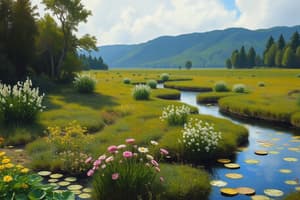Podcast
Questions and Answers
Which process is essential for the transformation of energy in living organisms?
Which process is essential for the transformation of energy in living organisms?
- Respiration (correct)
- Synthesis
- Assimilation
- Segregation
What is the primary function of DNA in living organisms?
What is the primary function of DNA in living organisms?
- Nutrient absorption
- Energy production
- Cell division
- Protein synthesis (correct)
Which of the following components plays a critical role in maintaining homeostasis within an organism?
Which of the following components plays a critical role in maintaining homeostasis within an organism?
- Nucleus
- Ribosome
- Cell membrane (correct)
- Chloroplast
Which of the following is NOT a characteristic of life?
Which of the following is NOT a characteristic of life?
In the context of ecology, what does the term 'niche' refer to?
In the context of ecology, what does the term 'niche' refer to?
Flashcards
Bioremediation
Bioremediation
A process that uses living organisms to clean up pollution.
Taxonomic Group
Taxonomic Group
A group of organisms that share a common ancestor and have similar characteristics.
Ecology
Ecology
The study of the relationships between organisms and their environment.
Biodiversity
Biodiversity
Signup and view all the flashcards
Evolution
Evolution
Signup and view all the flashcards
Study Notes
Summary of Succession
- Succession is the change a community goes through as it ages.
- A predictable series of plant and animal species fill roles and then disappear in each biome.
- Succession starts with pioneer species and ends with a climax species.
- Communities are named by their climax species (e.g., aspen forest).
Types of Succession
-
Primary Succession: Begins on bare rock (e.g., after a volcanic eruption).
- Lichen and moss colonize rock surfaces, breaking it into soil.
- Larger plant species grow after enough soil is formed.
- Suitable species survive due to changing habitats.
-
Secondary Succession: Begins on existing soil (e.g., after a fire or deforestation).
- Requires less time because soil already exists.
- Pioneer species (small plants) appear quickly and are replaced by larger plants.
- Eventually, a stable forest community forms.
Causes of Succession
- Natural events (e.g., fires, floods, volcanic eruptions)
- Human disturbances (e.g., deforestation, farming)
Pioneer Species
- First species to colonize an area
- Often small, fast-growing species (e.g., lichen, mosses)
- Help build soil.
Climax Species
- The final and stable species in a succession.
- Usually large trees and other complex plants.
- Give the community its name (e.g., aspen forest).
Why Succession Occurs
- Species changing the habitat and resources available.
- Harsh conditions initially select for species that can tolerate those conditions.
- More hospitable conditions allow less tolerant species to move in and outcompete others.
- Communities become more diverse over time.
- Eventually, stable climax species dominate.
Studying That Suits You
Use AI to generate personalized quizzes and flashcards to suit your learning preferences.




